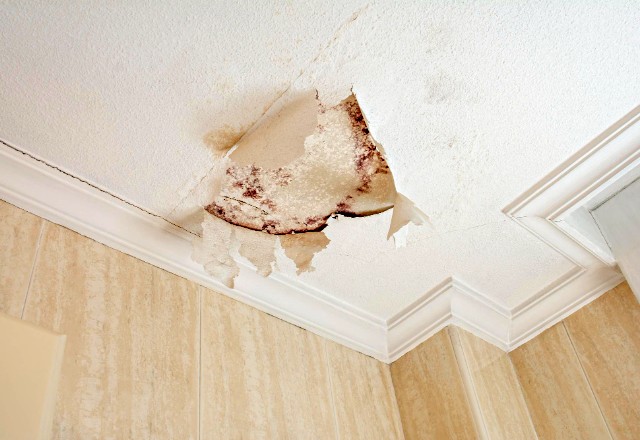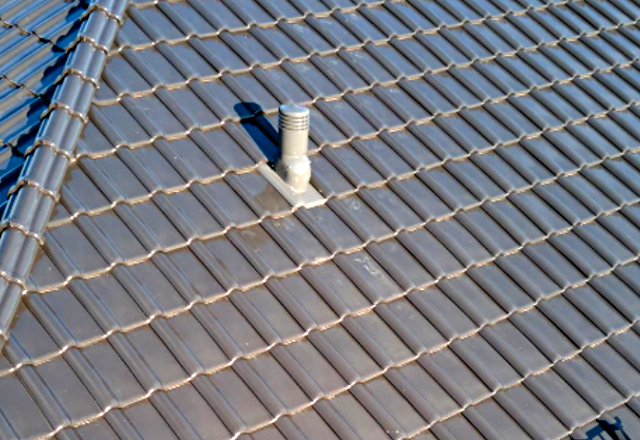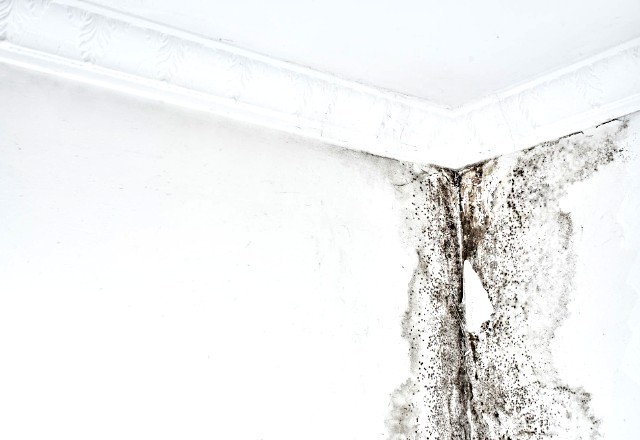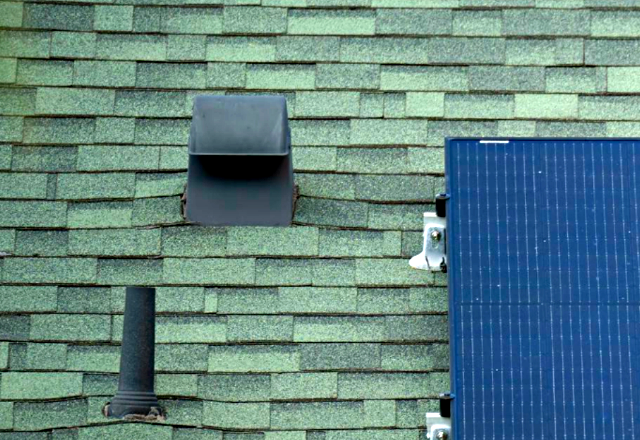A dripping roof vent oozing water inside the house is wildly inconvenient. Shelling out hundreds so a pro can fix what seems like a minor dribble adds insult to injury. But before whipping out your wallet, get this – in most cases, even total DIY beginners can patch up pesky leaks using everyday items found around the home for the cost of a pizza.
Why Roof Vent Leaks Happen
The problenm can occur due to various reasons. The most common causes include:
Deteriorated or damaged flashing
One of the main reasons is deteriorated or damaged flashing. Flashing is a thin strip of metal or other waterproof material that is installed around roof vents to create a watertight seal. Over time, exposure to the elements can cause the flashing to corrode, crack, or become loose. When this happens, water can seep through the gaps and enter your home.
Cracked vent boots
Boots are rubber or plastic coverings that are placed over the pipe to protect it from water infiltration. However, constant exposure to the sun’s UV rays and extreme temperature changes can cause the boots to become brittle and crack over time. When this occurs, water can easily find its way into your home through the cracks.
Worn–out seals
Seals are used to create a tight and waterproof connection between the pipe and the roof. However, with age and exposure to the elements, these seals can deteriorate, become loose, or lose their elasticity. As a result, water can penetrate through the weakened seals and appear inside your home.
Extreme weather conditions
Heavy rain can overwhelm the ventilation system and cause water to seep through any weak points or gaps. Windstorms can also create pressure differentials that force water into the system, leading to leakage. In most cases roof vent leaks during heavy rain are obvious. But it is important to note that the issue may not be immediately noticeable.
 Signs and Symptoms
Signs and Symptoms
Some signs to watch out for include water stains on the ceiling or walls, musty odors, mold growth, and visible drips or water pooling near the vent area. Being aware of these symptoms will help you take action promptly and avoid more extensive repairs.
The Importance of Fixing The Issue
Fixing a leaky roof vent is crucial for several reasons.
- Firstly, it protects your home from water damage, which can lead to structural issues and costly repairs.
- Secondly, it helps maintain indoor air quality by preventing mold and mildew growth.
- Lastly, addressing the problem promptly saves you money in the long run by preventing further damage and the need for more extensive repairs.
Addressing the Problem: Your Options
When addressing the issue, it is crucial to identify the underlying cause accurately. This often requires a thorough inspection by a professional contractor who can assess the condition of the flashing, boots, and seals. Once the cause of the leak is determined, appropriate repairs or replacements can be made to ensure a watertight seal and prevent future issues.
It’s obvious you want to know the prices and timeline.
Roof inspection approx. cost: 70 – 200 $
Dration: 40 min – 2 hours
Vent replacement average cost: 75-250 $
Duration: 30 min – 2-3 hours
 Materials Needed for Patching a Roof Vent
Materials Needed for Patching a Roof Vent
Before proceeding to patching up, gather essential supplies like roofing cement, a putty knife, wire brush, caulk gun, silicone or asphalt sealant, and possibly a replacement boot. Consider a few cost factors:
- If you don’t have materials on hand, buying everything could exceed hiring a roofer when labor is factored in.
- While budget sealants are available at 20$, paying a bit more for name brand ensures better quality and durability.
- New vents range widely in price – a contractor’s vent plus install costs might compare favorably to some DIY parts.
Evaluate whether your specific leak situation merits purchasing supplies or if you’d come out ahead paying for a one-time repair service. Regardless of approach, address any issues promptly before water damage escalates.
Step–by–Step Guide
Follow these steps to fix the problem:
- Start by inspecting the roofing accessory to determine the source of the leak. Look for any visible cracks, gaps, or deteriorated seals.
- Using a wire brush, clean the area around the pipe to remove any dirt, debris, or old sealant. A clean surface will ensure better adhesion.
- Apply cement to the affected area, covering any cracks or gaps. Use a putty knife to spread the cement evenly.
- If the boot is damaged, remove it carefully and replace it with a new one. Follow the manufacturer’s instructions for installation.
- Once the cement has dried, apply silicone sealant around the edges. This provides an additional layer of waterproofing and helps seal any remaining gaps.
Remember to follow safety precautions while working at heights and always use appropriate protective gear.
Common Mistakes to Avoid
While the repair process may seem straightforward, there are some common mistakes you should avoid:
- Not thoroughly inspecting the issue: Ensure you identify all potential sources of leaks before proceeding with the patching process.
- Applying insufficient cement or sealant: Make sure to cover the entire affected area adequately to prevent any water damage problems in future.
- Using poor quality materials: Investing in high-quality roofing cement and sealant will ensure a more effective and long-lasting repair.
- Ignoring safety precautions: Always prioritize your safety by using appropriate equipment and following proper procedures.
Tips for Extending the Lifespan of a Patched Vent
Once you have finished with patching, it’s essential to take steps to extend the lifespan of your roofing accessory. Consider the following tips:
- Regularly inspect it for any signs of damage or wear.
- Keep the surrounding area clean and free from debris.
- Check the seals periodically and apply additional sealant as needed.
- Address any potential issues promptly to prevent minor problems from escalating into major water damage.
Cost–Effective Alternatives to Patching
In some cases, patching may not be the most cost-effective solution, especially if the damage is extensive or the vent is old. In such acase you may choose from one of these alternatives:
- Replacing the boot: If it is damaged or worn out, replacing it with a new one can provide a more reliable long-term solution.
- Upgrading to a higher quality model: Investing in a higher-quality item can help preventprovide better overall performance.
- Seeking professional help: If you’re unsure about your DIY skills or if the damage is severe, it’s best to consult professional roofers. They can assess the situation and recommend the most appropriate solution.
While these alternatives may involve a higher upfront cost, they can offer a more durable and reliable fix in the long run.
When to Seek Professional Help
While DIY repairs can be effective for minor leaks, there are instances where it’s best to seek professional help. Consider the following scenarios:
- The damage is extensive, and a DIY fix may not provide a long-term solution.
- You’re unsure about the cause of the leak and need an expert opinion.
- Your roof is steep or difficult to access, requiring specialized equipment and training.
- You lack the time, tools, or confidence to undertake the repair yourself.
By recognizing when to call in a professional, you can ensure the problem is addressed correctly and minimize the risk of further damage.
Preventing Future Leaks: Maintenance Tips and Tricks
Prevention is always better than cure. Here are some maintenance tips to help you avoid future problems:
- Regularly inspect your roof for any signs of damage, including loose or missing shingles. Make sure your roof and all accessories are in top condition.
- Trim overhanging branches to prevent them from rubbing against the roof and potentially damaging the vent.
- Keep gutters and downspouts clean to ensure proper water drainage and prevent backups that can damage the roof.
- Monitor your attic for any signs of moisture or water intrusion that could indicate a problem.
Dealing with such an issue is never ideal, but it doesn’t have to break the bank. By understanding why it happen, recognizing the signs and symptoms, and promptly addressing them, you can save money and prevent further damage. With the step-by-step guide we provided, along with tips for avoiding common mistakes and extending the lifespan of a patched roof vent, you should be well-equipped to tackle the issue on your own.



 509-201-4190
509-201-4190

 Signs and Symptoms
Signs and Symptoms Materials Needed for Patching a Roof Vent
Materials Needed for Patching a Roof Vent
